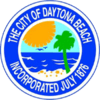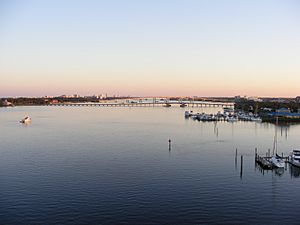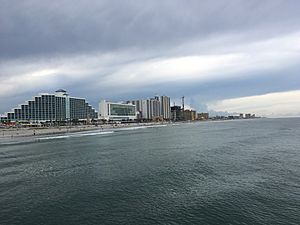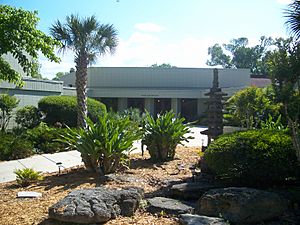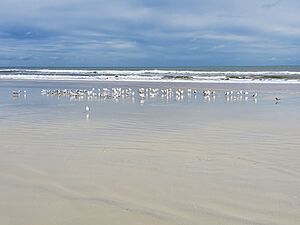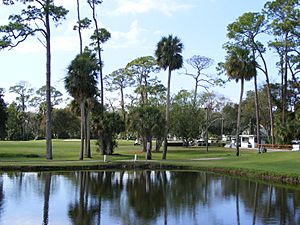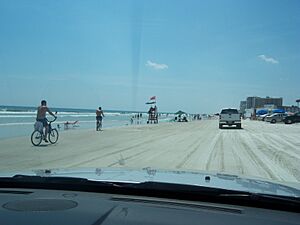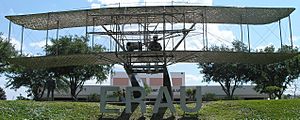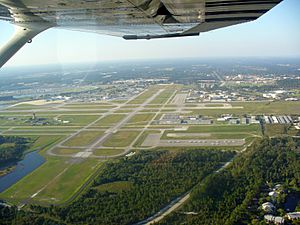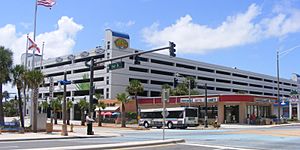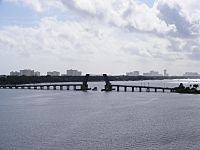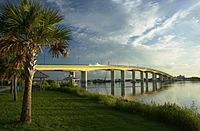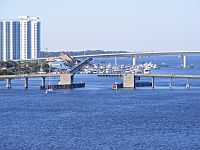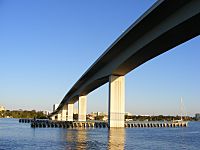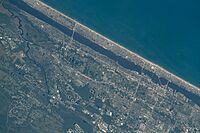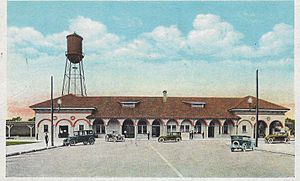Daytona Beach, Florida facts for kids
Quick facts for kids
Daytona Beach, Florida
|
|||
|---|---|---|---|
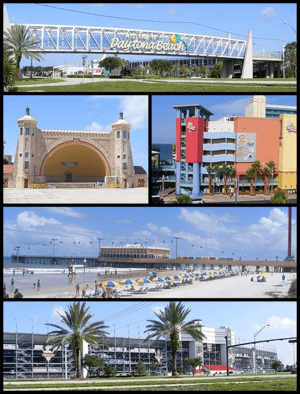
From top, left to right: Welcome sign when entering Daytona Beach; Daytona Beach Bandshell; Ocean Walk Shoppes; Daytona Beach Pier; Daytona International Speedway
|
|||
|
|||
| Nicknames:
"The World's Most Famous Beach", "The Spring Break Capital of the World"
|
|||
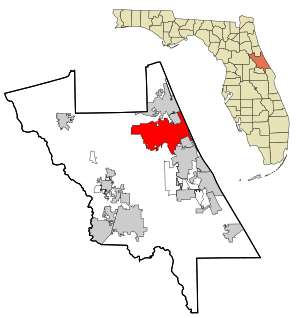
Location in Volusia County and the state of Florida
|
|||
| Country | United States | ||
| State | Florida | ||
| County | Volusia | ||
| Founded | 1870 | ||
| Incorporated (Town of Daytona) |
July 26, 1876 | ||
| Incorporated (City of Daytona Beach) | 1926 | ||
| Government | |||
| • Type | Commission–Manager | ||
| Area | |||
| • City | 68.19 sq mi (176.62 km2) | ||
| • Land | 65.59 sq mi (169.89 km2) | ||
| • Water | 2.60 sq mi (6.74 km2) | ||
| • Urban | 212.36 sq mi (550.0 km2) | ||
| Elevation | 13 ft (4 m) | ||
| Population
(2020)
|
|||
| • City | 72,647 | ||
| • Density | 1,107.54/sq mi (427.62/km2) | ||
| • Urban | 402,126 (104th U.S.) | ||
| • Urban density | 1,893.6/sq mi (731.1/km2) | ||
| • Metro | 668,921 (87th U.S.) | ||
| • CSA | 4,197,095 (15th U.S.) | ||
| Time zone | UTC−5 (EST) | ||
| • Summer (DST) | UTC−4 (EDT) | ||
| ZIP Codes |
32114–32126, 32198
|
||
| Area code(s) | 386 | ||
| FIPS code | 12-16525 | ||
| GNIS feature ID | 0281353 | ||
Daytona Beach is a popular resort city located in Volusia County, Florida, in the United States. It sits right on the East Coast of the United States. In 2020, about 72,647 people lived there. Daytona Beach is a main city in the Deltona–Daytona Beach–Ormond Beach metropolitan area. It is also part of Florida's "Fun Coast" region.
Daytona Beach is famous for its wide, hard-packed sand beach. You can even drive cars on some parts of it! Because of this unique beach, car and motorcycle races became very popular here. The Daytona Beach and Road Course hosted races for over 50 years. Later, in 1959, the Daytona International Speedway was built. The city is also the main home for NASCAR, a big racing organization.
Daytona Beach welcomes many tourists every year. Some big events include Speedweeks, which brings 200,000 visitors for the Daytona 500 race. Other exciting events are the NASCAR Coke Zero Sugar 400, Daytona Beach Bike Week, Biketoberfest, and the 24 Hours of Daytona endurance race.
Contents
- History of Daytona Beach
- Daytona Beach Geography
- Daytona Beach Population
- Daytona Beach Economy
- Arts and Culture in Daytona Beach
- Sports in Daytona Beach
- Parks and Recreation in Daytona Beach
- Education in Daytona Beach
- Media in Daytona Beach
- Daytona Beach Infrastructure
- Famous People from Daytona Beach
- Images for kids
- See also
History of Daytona Beach
The area where Daytona Beach is today was once home to the Timucuan Indians. They lived in villages protected by fences. Over time, contact with Europeans, through wars and diseases, caused the Timucuan people to disappear. Later, Seminole Indians, who came from the Creek tribes in Georgia and Alabama, also visited this area.
During the time when Florida was ruled by the British (1763–1783), an important road called the King's Road went through what is now Daytona Beach. This road connected Saint Augustine to New Smyrna. In 1871, a man named Mathias Day Jr. from Ohio bought a large piece of land here. He built a hotel, and a town started to grow around it. Even though Day faced money problems and lost his land, the people decided to name the town "Daytona" in his honor. The town officially became a city in 1876.
In 1886, the St. Johns & Halifax River Railway reached Daytona. This made it easier for people to travel to and from the city. In 1926, several smaller towns like Daytona, Daytona Beach, Kingston, and Seabreeze joined together to form "Daytona Beach." By the 1920s, it was already known as "The World's Most Famous Beach."
Daytona's Racing History
Daytona's wide, smooth sand beach was perfect for car and motorcycle races. These races started as early as 1902. Famous racers like William K. Vanderbilt and Malcolm Campbell came to Daytona to try and set new land speed records. In 1935, Malcolm Campbell set a record of 276.816 miles per hour on the beach. This was the last time a land speed record was set there.
On March 8, 1936, the first stock car race was held on the Daytona Beach Road Course. In 1958, William France Sr. and NASCAR built the Daytona International Speedway. This new track replaced the beach course for major races. Today, cars are still allowed on most parts of the beach, but they must drive very slowly, at a maximum speed of 10 miles per hour.
Daytona Beach Geography
Daytona Beach covers about 64.93 square miles. Most of this area is land, but 6.25 square miles is water. This means about 9.6% of the city is water.
The city is divided into two parts by the Halifax River lagoon. This river is part of the Intracoastal Waterway and flows into the Atlantic Ocean. Daytona Beach is next to Holly Hill and Ormond Beach to the north. To the south, it borders Daytona Beach Shores, South Daytona, and Port Orange.
Daytona Beach has experienced some strong weather. Hurricane Donna hit in 1960, and Hurricane Charley in 2004. In 1992, a large 9-foot high rogue wave hit the beach. It caused damage and injured 75 people.
Daytona Beach Climate
Daytona Beach has a humid subtropical climate. This means it has two main seasons. There's a warmer, wetter season from late May to October. Then there's a cooler, drier season from November to April.
In summer, temperatures are usually warm. It rarely gets above 95°F. The last time it reached 100°F was in 1999. During summer, warm, moist air from the Bahamas and Gulf of Mexico brings daily thunderstorms. This is why most of the yearly rainfall happens from June to September.
In winter, January is usually the coolest month, with an average temperature of 58.8°F. Sometimes, cold fronts can bring freezing temperatures. But it's very rare for the temperature to drop below 25°F. Like many parts of Florida, late winter and early spring can be very dry. This can sometimes lead to brush fires and water restrictions.
The coldest temperature ever recorded was 15°F in 1985. The hottest was 102°F in 1981 and 1944. The most rain in one day was 12.85 inches in 1924.
| Climate data for Daytona Beach, Florida (Daytona Beach International Airport), 1991–2020 normals, extremes 1923–present | |||||||||||||
|---|---|---|---|---|---|---|---|---|---|---|---|---|---|
| Month | Jan | Feb | Mar | Apr | May | Jun | Jul | Aug | Sep | Oct | Nov | Dec | Year |
| Record high °F (°C) | 92 (33) |
89 (32) |
92 (33) |
96 (36) |
100 (38) |
102 (39) |
102 (39) |
101 (38) |
99 (37) |
95 (35) |
90 (32) |
88 (31) |
102 (39) |
| Mean maximum °F (°C) | 82.0 (27.8) |
83.9 (28.8) |
87.3 (30.7) |
89.7 (32.1) |
93.8 (34.3) |
95.0 (35.0) |
95.4 (35.2) |
95.3 (35.2) |
92.7 (33.7) |
89.5 (31.9) |
85.2 (29.6) |
82.5 (28.1) |
96.9 (36.1) |
| Mean daily maximum °F (°C) | 69.0 (20.6) |
71.7 (22.1) |
75.5 (24.2) |
80.2 (26.8) |
85.0 (29.4) |
88.6 (31.4) |
90.2 (32.3) |
89.8 (32.1) |
87.3 (30.7) |
82.2 (27.9) |
76.1 (24.5) |
71.5 (21.9) |
80.6 (27.0) |
| Daily mean °F (°C) | 58.8 (14.9) |
61.4 (16.3) |
65.2 (18.4) |
70.2 (21.2) |
75.6 (24.2) |
80.2 (26.8) |
81.9 (27.7) |
81.9 (27.7) |
80.1 (26.7) |
74.4 (23.6) |
67.0 (19.4) |
61.8 (16.6) |
71.5 (21.9) |
| Mean daily minimum °F (°C) | 48.5 (9.2) |
51.1 (10.6) |
54.8 (12.7) |
60.1 (15.6) |
66.2 (19.0) |
71.8 (22.1) |
73.5 (23.1) |
74.1 (23.4) |
72.9 (22.7) |
66.7 (19.3) |
57.9 (14.4) |
52.1 (11.2) |
62.5 (16.9) |
| Mean minimum °F (°C) | 31.4 (−0.3) |
34.6 (1.4) |
38.9 (3.8) |
46.4 (8.0) |
55.7 (13.2) |
66.3 (19.1) |
70.0 (21.1) |
70.4 (21.3) |
66.7 (19.3) |
52.0 (11.1) |
42.2 (5.7) |
35.7 (2.1) |
29.7 (−1.3) |
| Record low °F (°C) | 15 (−9) |
24 (−4) |
26 (−3) |
32 (0) |
40 (4) |
52 (11) |
60 (16) |
63 (17) |
52 (11) |
39 (4) |
25 (−4) |
19 (−7) |
15 (−9) |
| Average precipitation inches (mm) | 2.73 (69) |
2.34 (59) |
3.63 (92) |
2.23 (57) |
3.69 (94) |
6.94 (176) |
6.01 (153) |
6.58 (167) |
7.15 (182) |
4.85 (123) |
2.76 (70) |
2.34 (59) |
51.25 (1,302) |
| Average precipitation days (≥ 0.01 in) | 8.0 | 6.7 | 7.6 | 6.3 | 7.4 | 14.7 | 13.7 | 14.8 | 14.5 | 10.8 | 7.2 | 7.6 | 119.3 |
| Source: NOAA | |||||||||||||
Daytona Beach Population
| Historical population | |||
|---|---|---|---|
| Census | Pop. | %± | |
| 1910 | 331 | — | |
| 1920 | 825 | 149.2% | |
| 1930 | 16,598 | 1,911.9% | |
| 1940 | 22,584 | 36.1% | |
| 1950 | 30,167 | 33.6% | |
| 1960 | 37,395 | 24.0% | |
| 1970 | 45,327 | 21.2% | |
| 1980 | 54,176 | 19.5% | |
| 1990 | 61,921 | 14.3% | |
| 2000 | 64,112 | 3.5% | |
| 2010 | 61,005 | −4.8% | |
| 2020 | 72,647 | 19.1% | |
| U.S. Decennial Census | |||
How Diverse is Daytona Beach?
| Race | Pop 2010 | Pop 2020 | % 2010 | % 2020 |
|---|---|---|---|---|
| White (NH) | 33,179 | 37,355 | 54.39% | 51.42% |
| Black or African American (NH) | 21,254 | 22,945 | 34.84% | 31.58% |
| Native American or Alaska Native (NH) | 185 | 169 | 0.30% | 0.23% |
| Asian (NH) | 1,354 | 1,902 | 2.22% | 2.62% |
| Pacific Islander or Native Hawaiian (NH) | 21 | 36 | 0.03% | 0.05% |
| Some other race (NH) | 144 | 468 | 0.24% | 0.64% |
| Two or more races/Multiracial (NH) | 1,113 | 3,003 | 1.82% | 4.13% |
| Hispanic or Latino (any race) | 3,755 | 6,769 | 6.16% | 9.32% |
| Total | 61,005 | 72,647 |
In 2020, Daytona Beach had 72,647 people living there. There were 28,763 households and 14,607 families. In 2010, the city had 61,005 people.
Daytona Beach Economy
Tourism is a very important part of Daytona Beach's economy. Over 8 million people visited the city in 2004. Manufacturing also brings in money. Daytona Beach has special industrial areas and foreign trade zones near Daytona Beach International Airport. These zones help businesses grow.
Many companies and organizations have their main offices or a big presence in the Daytona Beach area. These include:
- Brown & Brown
- Halifax Health
- Halifax Media Group
- International Speedway Corporation
- Gambro-Renal Products
- Ladies Professional Golf Association
- NASCAR
- Embry-Riddle Aeronautical University
Where to Shop in Daytona Beach?
Daytona Beach has several places to shop:
- Volusia Mall: This is the biggest shopping mall in Daytona Beach.
- Ocean Walk Shoppes: This is an outdoor shopping center.
- Tanger Outlets: A large retail center with many stores.
Top Employers in Daytona Beach
Here are some of the biggest employers in Daytona Beach:
| # | Employer | # of Employees |
|---|---|---|
| 1 | Volusia County School District | 7,623 |
| 2 | Halifax Health | 4,050 |
| 3 | Volusia County, Florida | 3,408 |
| 4 | AdventHealth Daytona Beach | 2,288 |
| 5 | Embry-Riddle Aeronautical University | 2,003 |
| 6 | Daytona State College | 1,250 |
| 7 | The City of Daytona Beach, Florida | 921 |
| 8 | Bethune Cookman University | 843 |
| 9 | Florida Hospital Healthcare Partner | 697 |
| 10 | SMA Healthcare | 677 |
Arts and Culture in Daytona Beach
The Museum of Arts and Sciences is the main cultural place in Daytona Beach. Other museums include the Southeast Museum of Photography and the Halifax Historical Museum. The Museum of Arts and Sciences has many different collections. It features a Cuban Museum and the Root Family Museum, which has one of the world's largest Coca-Cola collections. It also has the Cici and Hyatt Brown Museum of Art, home to the biggest collection of Florida art. There are also changing exhibits and a science center for kids.
Since 1952, the Daytona Beach Symphony Society has brought orchestras, opera, and dance companies to perform at the Peabody Auditorium.
Special Events in Daytona Beach
Daytona Beach hosts many special events that attract millions of tourists each year:
- Speedweeks: This includes the Daytona 500 NASCAR race and the Rolex 24 sports car race.
- Coke Zero Sugar 400: Another big NASCAR race held in July.
- Daytona Beach Bike Week: Motorcycle races, bike shows, and a huge gathering of bikers in March.
- Spring break: Many college students visit Daytona Beach during their spring break, usually in March.
During motorcycle events like Bike Week and Biketoberfest, hundreds of thousands of bikers come to the area. Daytona Beach is also a popular spot for college students during spring break.
Other Fun Places to Visit
- Daytona 500 Experience
- Daytona International Speedway
- Daytona Beach Boardwalk
- Daytona Lagoon Water Park
- Halifax Historical Museum
- Jackie Robinson Ballpark
- Main Street Pier
- Mary McLeod Bethune Performing Arts Center and Visual Arts Gallery
- Museum of Arts and Sciences
- News Journal Center
- Southeast Museum of Photography
- The Ocean Center
Sports in Daytona Beach
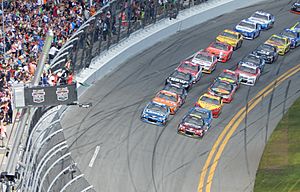
Motorsports in Daytona Beach
The Daytona International Speedway hosts two major annual races: the 24 Hours of Daytona and the famous Daytona 500.
Baseball in Daytona Beach
The Daytona Tortugas are a minor league baseball team. They play at Jackie Robinson Ballpark. The team started in 1993 and has won six championships.
Parks and Recreation in Daytona Beach
Daytona Beach has over 23 miles of public beaches. It also has more than ten waterfront parks. You can even drive cars on some parts of the beaches!
For golf lovers, there are notable courses like the Daytona Beach Golf Course, which opened in 1922, and LPGA International.
Education in Daytona Beach
Schools for Kids and Teens
Public schools in Daytona Beach are managed by Volusia County Schools. The city has two public high schools, two middle schools, and six elementary schools. A larger private school is Father Lopez Catholic High School.
Elementary Schools
- Beachside Elementary
- Champion Elementary
- Palm Terrace Elementary
- R.J. Longstreet Elementary
- Turie T. Small Elementary
- Westside Elementary
Middle Schools
- Campbell Middle School
- David C. Hinson Middle School
High Schools
- Mainland High School
- Seabreeze High School
Colleges and Universities in Daytona Beach
Daytona Beach is home to several colleges and universities:
- Bethune–Cookman University
- Daytona State College
- Embry–Riddle Aeronautical University
- University of Central Florida, Daytona Beach Campus
Vocational Schools in Daytona Beach
These schools offer training for specific jobs:
- The Airline Academy: Teaches people to become pilots and other airline professionals.
- Keiser College
- Phoenix East Aviation: Also offers flight training for pilots.
- WyoTech: Provides training for motorcycle and marine repair.
Media in Daytona Beach
Newspapers in Daytona Beach
- The Daytona Beach News-Journal: A daily newspaper for the greater Daytona Beach area.
- Hometown News: A weekly newspaper for the area.
- East Coast Current: A community newspaper covering Volusia County.
- Orlando Sentinel: A newspaper from Orlando with a section about Daytona Beach.
- The Avion Newspaper: The student newspaper for Embry–Riddle Aeronautical University.
- The Daytona Times: A newspaper for the Black community in Daytona Beach.
- HeadlineSurfer.com: An online-only newspaper.
Radio Stations in Daytona Beach
AM Radio
- WNDB, 1150 AM: News, talk, and sports.
- WROD, 1340 AM: Plays classic rock.
- WMFJ, 1450 AM: Religious programs.
- WDJZ, 1590 AM: Adult contemporary music, news, and talk.
FM Radio
- WHOG-FM, 95.7 FM: Plays classic rock.
- WCFB, 94.5 FM: Urban adult contemporary music.
- WJHM, 101.9 FM: Plays classic hip hop.
- WIKD-LP, 102.5 FM: The campus radio station for Embry–Riddle Aeronautical University.
- W231CN, 94.1 FM: Urban contemporary music, known as "HOT 94.1."
Television Channels in Daytona Beach
- WESH, Channel 2 (digital channel 11): An NBC affiliate.
- WDSC-TV, Channel 15 (digital channel 24): An educational independent station.
- Spectrum News 13, cable channel 13: A local news channel.
Daytona Beach Infrastructure
Law Enforcement in Daytona Beach
The Daytona Beach Police Department (DBPD) provides law enforcement for the city. It has 241 members and is led by Police Chief Craig Capri. The Volusia County Sheriff's office also helps with law enforcement in the county, including Daytona Beach, especially during big events like the Daytona 500. The Volusia County Beach Patrol also helps keep the beaches safe and provides emergency medical services.
Healthcare in Daytona Beach
Halifax Health is the main healthcare provider in Daytona Beach. It used to be called Halifax Hospital. There are also many other doctors and medical groups in the area.
City Services in Daytona Beach
The city government provides basic services like water and sewer.
- Florida Power & Light provides electricity.
- TECO/People's Gas provides natural gas.
- Spectrum and AT&T provide cable services.
- AT&T provides local phone service.
The city also has a successful recycling program. Different trucks pick up garbage, yard waste, and recycling.
Transportation in Daytona Beach
Airports in Daytona Beach
You can fly into Daytona Beach International Airport (DAB). It's located right next to the Daytona International Speedway. The airport was built in 1992.
Currently, Delta Air Lines flies nonstop to Atlanta. American Airlines flies nonstop to Charlotte. From these cities, you can connect to flights all over the world. You can also take smaller charter flights from DAB to places in the Bahamas. Sunwing Airlines also has seasonal flights from Toronto, Canada. The airport is also used a lot for general aviation, especially by Embry–Riddle Aeronautical University, which has its campus there.
Larger airports nearby are Orlando International Airport and Jacksonville International Airport. Both are about 90 minutes away.
Buses in Daytona Beach
- Greyhound Bus Lines has a station in Daytona Beach. You can take Greyhound buses to Jacksonville and Orlando.
- Votran is the local bus service for Volusia County.
Driving in Daytona Beach
Daytona Beach is easy to reach by car. I-95 runs north and south through the city. I-4 connects Daytona Beach to Orlando and Tampa. US 1 also goes north and south through the city. US 92 runs east and west. SR A1A is a scenic road along the beach.
The Volusia County Parking Garage is a good place to park. It's near the Ocean Center, Daytona Lagoon, and the Ocean Walk Shoppes. It has over a thousand parking spaces.
Bridges in Daytona Beach
There are four bridges that cross the Halifax River in Daytona Beach. These bridges connect the mainland to the beachside. They are the Veterans Memorial Bridge, the Broadway Bridge, the Main Street Bridge, and the Seabreeze Bridge. None of these bridges charge a toll. The Veterans Memorial Bridge is being replaced with a new, higher bridge.
Trains in Daytona Beach
Passenger train service to Daytona Beach started in 1889. Trains like the City of Miami and the South Wind used to stop here. However, passenger train service ended in 1968. Today, the Florida East Coast Railroad (FEC) still runs freight trains through Daytona Beach.
You can still connect to Amtrak passenger trains from Daytona Beach. An Amtrak Thruway service (a taxi-cab) takes you to the DeLand station, which is about 28 miles west. From there, you can catch Amtrak's Silver Star and Silver Meteor trains.
Famous People from Daytona Beach
- Duane Allman and Gregg Allman, musicians
- Perry Baker, rugby player for U.S. national team
- Fulgencio Batista, former President of Cuba
- Pete Carr, musician
- Vince Carter, basketball player, 8-time NBA All-Star
- Ed Charles, Major League Baseball player
- Dimitri Diatchenko, actor
- Bill France Sr., founder of NASCAR
- Roland G. Fryer Jr., economist; youngest African-American to get tenure at Harvard University
- Kenneth C. Griffin, hedge fund manager and investor
- Lee H. Hamilton, U.S. congressman
- Danielle Harris, actress
- Carrenza Howard, baseball pitcher
- Zora Neale Hurston, writer and anthropologist
- Alex Kinsey, singer
- E. J. Kuale, professional football player
- Gary Russell Libby, art historian and museum director
- Ryan Lochte, swimmer, winner of 12 Olympic medals
- Martin Mayhew, pro football player and executive
- Mary McLeod Bethune, educator and civil rights activist
- Walter M. Miller Jr., author of A Canticle for Leibowitz
- Jane Morgan, singer
- Matthew Tyler Musto, musician
- Kevin Nash, professional WWE wrestler
- No Kum-sok, North Korean defector
- Ransom Eli Olds, automobile pioneer
- Pavlina Osta, radio host
- Josef Papp, engineer
- Kitty Pryde, rapper
- Glen "Fireball" Roberts, NASCAR driver
- Jackie Robinson, professional baseball player
- Bob Ross, artist and television host
- Galen Seaman, lawyer and former mayor of Daytona Beach
- David Sholtz, former governor of Florida
- Mike Skinner, NASCAR driver
- Lindsey Snell, journalist
- Marc-Aurèle de Foy Suzor-Coté, painter
- Howard Thurman, author and theologian
- Denzel Washington, actor
- Eric Weems, professional football player
- T. K. Wetherell, president of Florida State University
- Robert Wright, musical theater writer
- Smokey Yunick, mechanic and motor racing innovator
- Jacob Winchester, award-winning composer, writer, voice actor and director
Images for kids
See also
 In Spanish: Daytona Beach para niños
In Spanish: Daytona Beach para niños



